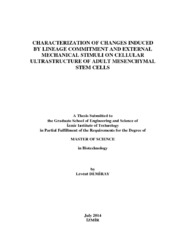Please use this identifier to cite or link to this item:
https://hdl.handle.net/11147/4178Full metadata record
| DC Field | Value | Language |
|---|---|---|
| dc.contributor.advisor | Özçivici, Engin | - |
| dc.contributor.author | Demiray, Levent | - |
| dc.date.accessioned | 2014-11-18T08:39:55Z | |
| dc.date.available | 2014-11-18T08:39:55Z | |
| dc.date.issued | 2014 | - |
| dc.identifier.uri | http://hdl.handle.net/11147/4178 | - |
| dc.description | Thesis (Master)--Izmir Institute of Technology, Biotechnology, Izmir, 2014 | en_US |
| dc.description | Includes bibliographical references (leaves: 26-31) | en_US |
| dc.description | Text in English; Abstract: Turkish and English | en_US |
| dc.description | ix, 38 leaves | en_US |
| dc.description.abstract | Mechanical vibrations have great impact on the regulation of bone cells and their precursor’s Mesenchymal stem cells. Anabolic effects of high frequency low magnitude mechanical vibrations on these cells are well identified whereas sensing mechanism of cells and their early response to mechanical stimuli is largely unknown. Here, we hypothesed that daily bouts of low intensity vibrations will affect cellular ultrastructure and the effect will interact with the osteogenic induction. To test this hypothesis mouse bone marrow stem cell line D1 ORL UVA were subjected to mechanical vibrations (0.15g, 90 Hz, 15min/d) for 7 days to both during quiescence and osteogenic commitment. Ultrastructural changes were identified on cellular and molecular levels. To characterize alterations in cell surface, Atomic force microscopy is used. Mechanical vibrations increased cell surface height, cell surface roughness and nucleus height significantly during quiescence and under osteogenic conditions. Moreover, in order to identify the changes in cytoskeleton structure, actin were stained with phalloidin and imaged with inverted microscope. To quantify phalloidin signals pixel frequency analysis were performed, signal intensities and thickness of actin fibers were measured. It was observed that mechanical stimulation and osteogenic induction effects number of actin fibers and their thickness significantly. Molecular level analysis of cytoskeleton elements and osteogenic markers were performed with Real time RT-PCR. Significant increases in osteogenic markers were detected with osteogenic induction. Unlikely, no relation between mechanical stimulation and osteogenic marker expression was observed. These results indicate that mesenchymal stem cells responds to mechanical vibrations by altering their ultrastructure in particular cytoskeleton during both quiescence and osteoblastogenesis. | en_US |
| dc.language.iso | en | en_US |
| dc.publisher | Izmir Institute of Technology | en_US |
| dc.rights | info:eu-repo/semantics/openAccess | en_US |
| dc.subject | Atomic force microscopy | en_US |
| dc.subject | Mechanical stimulation | en_US |
| dc.subject.lcsh | Mesenchymal stem cells | en_US |
| dc.subject.lcsh | Bone regeneration | en_US |
| dc.title | Characterization of Changes Induced by Lineage Commitment and External Mechanical Stimuli on Cellular Ultrastructure of Adult Mesenchymal Stem Cells | en_US |
| dc.title.alternative | Erişkin Kök Hücrelerinde Doku Yönelimi ve Dış Mekanik Etkilere Bağlı Gelişen Alt Yapısal Değişikliklerin Karakterizasyonu | en_US |
| dc.type | Master Thesis | en_US |
| dc.institutionauthor | Demiray, Levent | - |
| dc.department | Thesis (Master)--İzmir Institute of Technology, Bioengineering | en_US |
| dc.relation.publicationcategory | Tez | en_US |
| dc.identifier.wosquality | N/A | - |
| dc.identifier.scopusquality | N/A | - |
| item.openairecristype | http://purl.org/coar/resource_type/c_18cf | - |
| item.languageiso639-1 | en | - |
| item.openairetype | Master Thesis | - |
| item.grantfulltext | open | - |
| item.fulltext | With Fulltext | - |
| item.cerifentitytype | Publications | - |
| Appears in Collections: | Master Degree / Yüksek Lisans Tezleri | |
Files in This Item:
| File | Description | Size | Format | |
|---|---|---|---|---|
| 10013215.pdf | MasterThesis | 1.73 MB | Adobe PDF |  View/Open |
CORE Recommender
Page view(s)
228
checked on Mar 31, 2025
Download(s)
76
checked on Mar 31, 2025
Google ScholarTM
Check
Items in GCRIS Repository are protected by copyright, with all rights reserved, unless otherwise indicated.